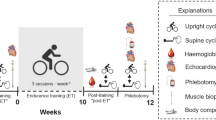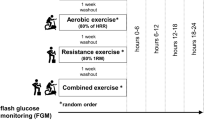Abstract
Blood O2 carrying capacity affects aerobic capacity (VO2max). Patients with type 1 diabetes have a risk for anaemia along with renal impairment, and they often have low VO2max. We investigated whether total haemoglobin mass (tHb-mass) and blood volume (BV) differ in men with type 1 diabetes (T1D, n = 12) presently without complications and in healthy men (CON, n = 23) (age-, anthropometry-, physical activity-matched), to seek an explanation for low VO2max. We determined tHb-mass, BV, haemoglobin concentration ([Hb]), and VO2max in T1D and CON. With similar (mean ± SD) [Hb] (144 vs. 145 g l−1), T1D had lower tHb-mass (10.1 ± 1.4 vs. 11.0 ± 1.1 g kg−1, P < 0.05), BV (76.8 ± 9.5 vs. 83.5 ± 8.3 ml kg−1, P < 0.05) and VO2max (35.4 ± 4.8 vs. 44.9 ± 7.5 ml kg−1 min−1, P < 0.001) than CON. VO2max correlated with tHb-mass and BV both in T1D (r = 0.71, P < 0.01 and 0.67, P < 0.05, respectively) and CON (r = 0.54, P < 0.01 and 0.66, P < 0.001, respectively), but not with [Hb]. Linear regression slopes were shallower in T1D than CON both between VO2max and tHb-mass (2.4 and 3.6 ml kg−1 min−1 vs. g kg−1, respectively) and VO2max and BV (0.3 and 0.6 ml kg−1 min−1 vs. g kg−1, respectively), indicating that T1D were unable to reach similar VO2max than CON at a given tHb-mass and BV. In conclusion, low tHb-mass and BV partly explained low VO2max in T1D and may provide early and more sensitive markers of blood O2 carrying capacity than [Hb] alone.

Similar content being viewed by others
Abbreviations
- BM:
-
Body mass
- BMI:
-
Body mass index
- BSA:
-
Body surface area
- BV:
-
Blood volume
- CON:
-
Healthy controls
- ECG:
-
Electrocardiography
- EDV:
-
End-diastolic volume
- EPO:
-
Erythropoietin
- EV:
-
Erythrocyte volume
- EXT:
-
Step incremental exercise protocol
- FFM:
-
Fat free mass
- FFMI:
-
Fat free mass index
- [Hb]:
-
Haemoglobin concentration
- HbA1c:
-
Glycated haemoglobin
- Hct:
-
Haematocrit
- HR:
-
Heart rate
- HRmax :
-
Heart rate at maximal exercise
- LTPA:
-
Leisure-time physical activity
- LV:
-
Left ventricular
- PV:
-
Plasma volume
- RAS:
-
Renin-angiotensin system
- RPE:
-
Borg rating of perceived exertion
- SpO2 :
-
Oxygen saturation of arterial blood
- SV:
-
Stroke volume
- T1D:
-
Patients with type 1 diabetes
- tHb-mass:
-
Total haemoglobin mass
- %TE:
-
Typical error
- V E :
-
Ventilation
- V Emax :
-
Ventilation at maximal exercise
- VO2max :
-
Aerobic capacity
References
American Diabetes Association (2004) Position statement. Physical activity/exercise and diabetes. Diabetes Care 27(S1):S58–62
Astor BC, Muntner P, Levin A, Eustace JA, Coresh J (2002) Association of kidney function with anemia: the Third National Health and Nutrition Examination Survey (1988–1994). Arch Intern Med 162(12):1401–1408
Balakumar P, Jagadeesh G (2010) Cardiovascular and renal pathologic implications of prorenin, renin, and the (pro)renin receptor: promising young players from the old renin-angiotensin-aldosterone system. J Cardiovasc Pharmacol 56(5):570–579
Baldi JC, Hofman PL (2010) Does careful glycemic control improve aerobic capacity in subjects with type 1 diabetes? Exerc Sport Sci Rev 38(4):161–167
Baldi JC, Cassuto NA, Foxx-Lupo WT, Wheatley CM, Snyder EM (2010) Glycemic status affects cardiopulmonary exercise response in athletes with type I diabetes. Med Sci Sports Exerc 42(8):1454–1459
Beaver WL, Lamarra N, Wasserman K (1981) Breath-by-breath measurement of true alveolar gas exchange. J Appl Physiol 51(6):1662–1675
Bosman DR, Winkler AS, Marsden JT, Macdougall IC, Watkins PJ (2001) Anemia with erythropoietin deficiency occurs early in diabetic nephropathy. Diabetes Care 24(3):495–499
Cherney DZ, Lai V, Scholey JW, Miller JA, Zinman B, Reich HN (2010) Effect of direct renin inhibition on renal hemodynamic function, arterial stiffness, and endothelial function in humans with uncomplicated type 1 diabetes: a pilot study. Diabetes Care 33(2):361–365
de la Sierra A, Salazar J (2011) What is the role of direct renin inhibitors in the treatment of the hypertensive diabetic patient? Adv Ther 28(9):716–727
Ditzel J (1976) Oxygen transport impairment in diabetes. Diabetes 25(2 SUPPL):832–838
Donnelly S (2001) Why is erythropoietin made in the kidney? The kidney functions as a critmeter. Am J Kidney Dis 38(2):415–425
Donnelly S, Shah BR (1999) Erythropoietin deficiency in hyporeninemia. Am J Kidney Dis 33(5):947–953
Dunn A, Donnelly S (2007) The role of the kidney in blood volume regulation: the kidney as a regulator of the hematocrit. Am J Med Sci 334(1):65–71
Ekblom B (1968) Effect of physical training on oxygen transport system in man. Acta Physiologica Scandinavica 328(S):1–45
Erslev AJ, Caro J, Besarab A (1985) Why the kidney? Nephron 41(3):213–216
Gore CJ, Hahn AG, Burge CM, Telford RD (1997) VO2max and haemoglobin mass of trained athletes during high intensity training. Int J Sports Med 18(6):477–482
Gusso S, Hofman P, Lalande S, Cutfield W, Robinson E, Baldi JC (2008) Impaired stroke volume and aerobic capacity in female adolescents with type 1 and type 2 diabetes mellitus. Diabetologia 51(7):1317–1320
Hopkins WG (2000) Measures of reliability in sports medicine and science. Sports Med 30(1):1–15
Jones AM, Carter H (2000) The effect of endurance training on parameters of aerobic fitness. Sports Med 29(6):373–386
Kanstrup IL, Ekblom B (1984) Blood volume and hemoglobin concentration as determinants of maximal aerobic power. Med Sci Sports Exerc 16(3):256–262
Kikkawa R, Kitamura E, Fujiwara Y, Haneda M, Shigeta Y (1986) Biphasic alteration of renin-angiotensin-aldosterone system in streptozotocin-diabetic rats. Ren Physiol 9(3):187–192
Komatsu WR, Gabbay MA, Castro ML, Saraiva GL, Chacra AR, de Barros Neto TL, Dib SA (2005) Aerobic exercise capacity in normal adolescents and those with type 1 diabetes mellitus. Pediatr Diabetes 6(3):145–149
Lalande S, Hofman PL, Baldi JC (2010) Effect of reduced total blood volume on left ventricular volumes and kinetics in type 2 diabetes. Acta Physiol (Oxf) 199(1):23–30
Lundby C, Thomsen JJ, Boushel R, Koskolou M, Warberg J, Calbet JA, Robach P (2007) Erythropoietin treatment elevates haemoglobin concentration by increasing red cell volume and depressing plasma volume. J Physiol 578(Pt 1):309–314
Lush DJ, King JA, Fray JC (1993) Pathophysiology of low renin syndromes: sites of renal renin secretory impairment and prorenin overexpression. Kidney Int 43(5):983–999
Meriwether RA, McMahon PM, Islam N, Steinmann WC (2006) Physical activity assessment: validation of a clinical assessment tool. Am J Prev Med 31(6):484–491
Mori H, Okubo M, Okamura M, Yamane K, Kado S, Egusa G, Hiramoto T, Hara H, Yamakido M (1992) Abnormalities of pulmonary function in patients with non-insulin-dependent diabetes mellitus. Intern Med 31(2):189–193
Mosteller RD (1987) Simplified calculation of body-surface area. N Engl J Med 317(17):1098
Nadeau KJ, Regensteiner JG, Bauer TA, Brown MS, Dorosz JL, Hull A, Zeitler P, Draznin B, Reusch JEB (2010) Insulin resistance in adolescents with type 1 diabetes and its relationship to cardiovascular function. J Clin Endocrinol Metab 95(2):513–521
Niranjan V, McBrayer DG, Ramirez LC, Raskin P, Hsia CCW (1997) Glycemic control and cardiopulmonary function in patients with insulin-dependent diabetes mellitus. Am J Med 103(6):504–513
Palmieri V, Capaldo B, Russo C, Iaccarino M, Pezzullo S, Quintavalle G, Di Minno G, Riccardi G, Celentano A (2008) Uncomplicated type 1 diabetes and preclinical left ventricular myocardial dysfunction: insights from echocardiography and exercise cardiac performance evaluation. Diabetes Res Clin Pract 79(2):262–268
Parisotto R, Gore CJ, Emslie KR, Ashenden MJ, Brugnara C, Howe C, Martin DT, Trout GJ, Hahn AG (2000) A novel method utilising markers of altered erythropoiesis for the detection of recombinant human erythropoietin abuse in athletes. Haematologica 85(6):564–572
Paulsen EP, Seip RL, Ayers CR, Croft BY, Kaiser DL (1989) Plasma renin activity and albumin excretion in teenage type I diabetic subjects. A prospective study. Hypertension 13(6 Pt 2):781–788
Peltonen JE, Koponen AS, Pullinen K, Hagglund H, Aho JM, Kyrolainen H, Tikkanen HO (2012) Alveolar gas exchange and tissue deoxygenation during exercise in type 1 diabetes patients and healthy controls. Respir Physiol Neurobiol 181(3):267–276
Prommer N, Heckel A, Schmidt W (2007) Timeframe to detect blood withdrawal associated with autologous blood doping. Med Sci Sports Exerc 39(5 Suppl):S3
Schmidt W, Prommer N (2005) The optimised CO-rebreathing method: a new tool to determine total haemoglobin mass routinely. Eur J Appl Physiol 95(5–6):486–495
Schmidt W, Prommer N (2010) Impact of Alterations in Total Hemoglobin Mass on VO2max. Exerc Sport Sci Rev 38(2):68–75
Schmidt WF, Doerfler C, Wachsmuth N, Voelzke C, Treff G, Thoma S, Steinacker JAN, Prommer N (2009) Influence of body mass, body composition, and performance state on total hemoglobin mass: 2790: Board #184 May 29 3:30 PM–5:00 PM. Med Sci Sports Exerc 41(5 Supplement 1):541
Thomas MC, MacIsaac RJ, Tsalamandris C, Molyneaux L, Goubina I, Fulcher G, Yue D, Jerums G (2004) Anemia in patients with type 1 diabetes. J Clin Endocrinol Metab 89(9):4359–4363
Traynor J, Mactier R, Geddes CC, Fox JG (2006) How to measure renal function in clinical practice. Br Med J 333(7571):733–737
Veves A, Saouaf R, Donaghue VM, Mullooly CA, Kistler JA, Giurini JM, Horton ES, Fielding RA (1997) Aerobic exercise capacity remains normal despite impaired endothelial function in the micro- and macrocirculation of physically active IDDM patients. Diabetes 46(11):1846–1852
Wanke T, Formanek D, Auinger M, Zwick H, Irsigler K (1992) Pulmonary gas exchange and oxygen uptake during exercise in patients with type 1 diabetes mellitus. Diabet Med 9(3):252–257
Acknowledgments
This study was partly funded by Tekes—the Finnish Funding Agency for Technology and Innovation (40043/07), and Ministry of Education and Culture. We thank Ari Suojalehto, MD, Department of Sports and Exercise Medicine, Institute of Clinical Medicine, University of Helsinki, Finland, and Maija Kopo, Foundation for Sports and Exercise Medicine, Helsinki, Finland, for the assistance in collecting the data, and Prof. Stephen Cheung of Brock University, Canada, for critical review of the manuscript.
Conflict of interest
The authors have no conflict of interests.
Author information
Authors and Affiliations
Corresponding author
Additional information
Communicated by Fabio Fischetti.
Rights and permissions
About this article
Cite this article
Koponen, A.S., Peltonen, J.E., Päivinen, M.K. et al. Low total haemoglobin mass, blood volume and aerobic capacity in men with type 1 diabetes. Eur J Appl Physiol 113, 1181–1188 (2013). https://doi.org/10.1007/s00421-012-2532-4
Received:
Accepted:
Published:
Issue Date:
DOI: https://doi.org/10.1007/s00421-012-2532-4




